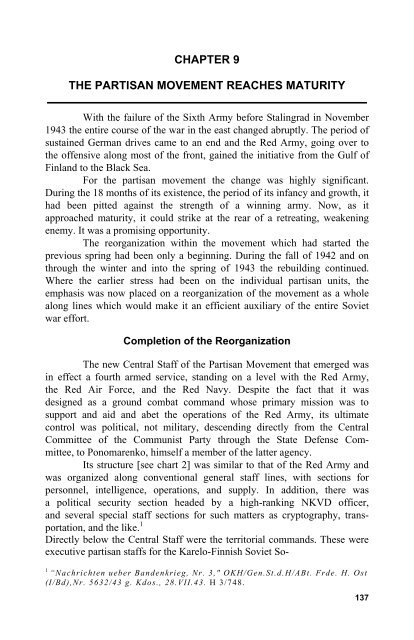the soviet partisan movement 1941-1944 by edgar m. howell
the soviet partisan movement 1941-1944 by edgar m. howell
the soviet partisan movement 1941-1944 by edgar m. howell
Create successful ePaper yourself
Turn your PDF publications into a flip-book with our unique Google optimized e-Paper software.
CHAPTER 9 <br />
THE PARTISAN MOVEMENT REACHES MATURITY <br />
With <strong>the</strong> failure of <strong>the</strong> Sixth Army before Stalingrad in November<br />
1943 <strong>the</strong> entire course of <strong>the</strong> war in <strong>the</strong> east changed abruptly. The period of<br />
sustained German drives came to an end and <strong>the</strong> Red Army, going over to<br />
<strong>the</strong> offensive along most of <strong>the</strong> front, gained <strong>the</strong> initiative from <strong>the</strong> Gulf of<br />
Finland to <strong>the</strong> Black Sea.<br />
For <strong>the</strong> <strong>partisan</strong> <strong>movement</strong> <strong>the</strong> change was highly significant.<br />
During <strong>the</strong> 18 months of its existence, <strong>the</strong> period of its infancy and growth, it<br />
had been pitted against <strong>the</strong> strength of a winning army. Now, as it<br />
approached maturity, it could strike at <strong>the</strong> rear of a retreating, weakening<br />
enemy. It was a promising opportunity.<br />
The reorganization within <strong>the</strong> <strong>movement</strong> which had started <strong>the</strong><br />
previous spring had been only a beginning. During <strong>the</strong> fall of 1942 and on<br />
through <strong>the</strong> winter and into <strong>the</strong> spring of 1943 <strong>the</strong> rebuilding continued.<br />
Where <strong>the</strong> earlier stress had been on <strong>the</strong> individual <strong>partisan</strong> units, <strong>the</strong><br />
emphasis was now placed on a reorganization of <strong>the</strong> <strong>movement</strong> as a whole<br />
along lines which would make it an efficient auxiliary of <strong>the</strong> entire Soviet<br />
war effort.<br />
Completion of <strong>the</strong> Reorganization<br />
The new Central Staff of <strong>the</strong> Partisan Movement that emerged was<br />
in effect a fourth armed service, standing on a level with <strong>the</strong> Red Army,<br />
<strong>the</strong> Red Air Force, and <strong>the</strong> Red Navy. Despite <strong>the</strong> fact that it was<br />
designed as a ground combat command whose primary mission was to<br />
support and aid and abet <strong>the</strong> operations of <strong>the</strong> Red Army, its ultimate<br />
control was political, not military, descending directly from <strong>the</strong> Central<br />
Committee of <strong>the</strong> Communist Party through <strong>the</strong> State Defense Committee,<br />
to Ponomarenko, himself a member of <strong>the</strong> latter agency.<br />
Its structure [see chart 2] was similar to that of <strong>the</strong> Red Army and<br />
was organized along conventional general staff lines, with sections for<br />
personnel, intelligence, operations, and supply. In addition, <strong>the</strong>re was<br />
a political security section headed <strong>by</strong> a high-ranking NKVD officer,<br />
and several special staff sections for such matters as cryptography, transportation,<br />
and <strong>the</strong> like. 1<br />
Directly below <strong>the</strong> Central Staff were <strong>the</strong> territorial commands. These were<br />
executive <strong>partisan</strong> staffs for <strong>the</strong> Karelo-Finnish Soviet So-<br />
1<br />
“Nachrichten ueber Bandenkrieg, Nr. 3," OKH/Gen.St.d.H/ABt. Frde. H. Ost<br />
(I/Bd),Nr. 5632/43 g. Kdos., 28.VII.43. H 3/748.<br />
137
















